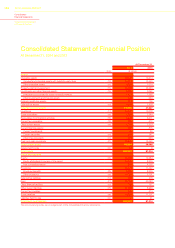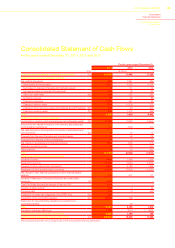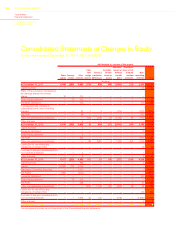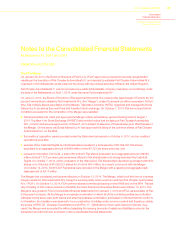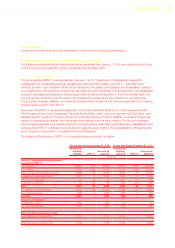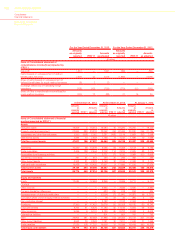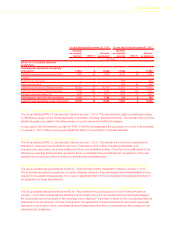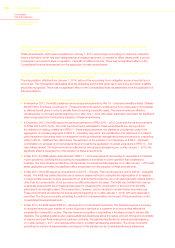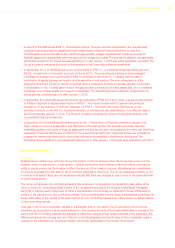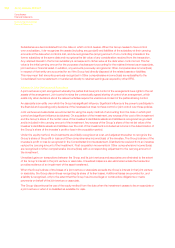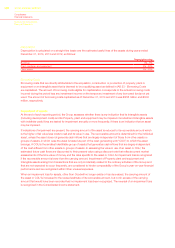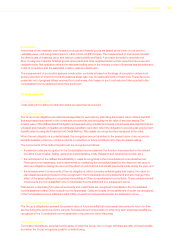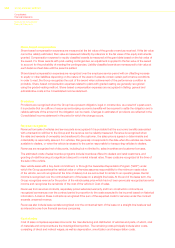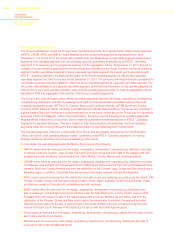Chrysler 2014 Annual Report Download - page 156
Download and view the complete annual report
Please find page 156 of the 2014 Chrysler annual report below. You can navigate through the pages in the report by either clicking on the pages listed below, or by using the keyword search tool below to find specific information within the annual report.
154 2014 | ANNUAL REPORT
Consolidated
Financial Statements
Notes to the Consolidated
Financial Statements
Subsidiaries are deconsolidated from the date on which control ceases. When the Group ceases to have control
over a subsidiary, it de-recognizes the assets (including any goodwill) and liabilities of the subsidiary at their carrying
amounts at the date when control is lost, and de-recognizes the carrying amount of non-controlling interests in the
former subsidiary at the same date and recognizes the fair value of any consideration received from the transaction.
Any retained interest in the former subsidiary is remeasured to its fair value at the date when control is lost. This fair
value is the initial carrying amount for the purposes of subsequent accounting for the retained interest as an associate,
joint venture or financial asset. In addition, any amounts previously recognized in Other comprehensive income/(loss)
in respect of that entity are accounted for as if the Group had directly disposed of the related assets or liabilities.
This may mean that amounts previously recognized in Other comprehensive income/(loss) are reclassified to the
Consolidated income statement or transferred directly to retained earnings as required by other IFRS.
Interests in Joint Ventures and Associates
A joint venture is a joint arrangement whereby the parties that have joint control of the arrangement have rights to the net
assets of the arrangement. Joint control involves the contractually agreed sharing of control of an arrangement, which
exists only when decisions about the relevant activities require the unanimous consent of the parties sharing control.
An associate is an entity over which the Group has significant influence. Significant influence is the power to participate in
the financial and operating policy decisions of the investees but does not have control or joint control over those policies.
Joint ventures and associates are accounted for using the equity method of accounting from the date on which joint
control and significant influence is obtained. On acquisition of the investment, any excess of the cost of the investment
and the Group’s share of the net fair value of the investee’s identifiable assets and liabilities is recognized as goodwill
and is included in the carrying amount of the investment. Any excess of the Group’s share of the net fair value of the
investee’s identifiable assets and liabilities over the cost of the investment is included as income in the determination of
the Group’s share of the investee’s profit or loss in the acquisition period.
Under the equity method, the investments are initially recognized at cost, and adjusted thereafter to recognize the
Group’s share of the profit or loss and Other comprehensive income/(loss) of the investee. The Group’s share of the
investee’s profit or loss is recognized in the Consolidated income statement. Distributions received from an investee
reduce the carrying amount of the investment. Post-acquisition movements in Other comprehensive income/(loss)
are recognized in Other comprehensive income/(loss) with a corresponding adjustment to the carrying amount of
the investment.
Unrealized gains on transactions between the Group and its joint ventures and associates are eliminated to the extent
of the Group’s interest in the joint venture or associate. Unrealized losses are also eliminated unless the transaction
provides evidence of an impairment of the asset transferred.
When the Group’s share of the losses of a joint venture or associate exceeds the Group’s interest in that joint venture
or associate, the Group discontinues recognizing its share of further losses. Additional losses are provided for, and
a liability is recognized, only to the extent that the Group has incurred legal or constructive obligations or made
payments on behalf of the joint venture or associate.
The Group discontinues the use of the equity method from the date when the investment ceases to be an associate or
a joint venture or when it is classified as available-for-sale.


